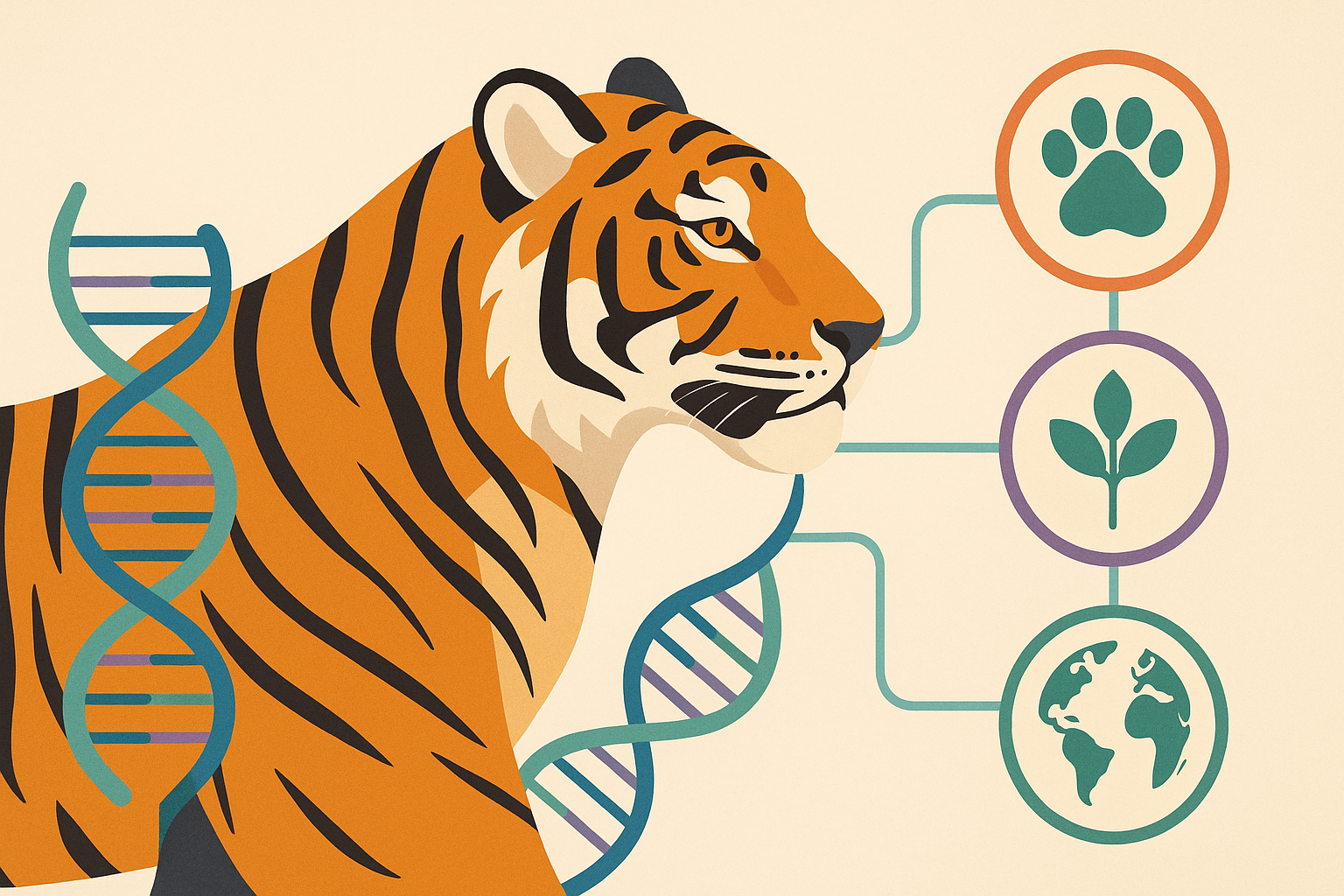Changing Stripes: How Genomics Can Reshape Wildlife Conservation
Hindustan Times

1. Introduction and Context
This editorial examines how genomics — the study of an organism’s DNA — is becoming a transformative tool in India’s wildlife conservation strategy.
Focusing on the black tigers of Similipal (Odisha), the article explains how genetic research helps identify mutations, measure inbreeding, and guide scientific breeding and relocation decisions.
The piece situates genomics within India’s urgent conservation challenges:
- habitat fragmentation
- inbreeding depression
- declining genetic diversity
- climate stress
- shrinking populations of big cats and other species
It argues that genomic science is now essential for modern conservation, both in India and globally.
2. Key Arguments Presented
a. Wildlife Populations Are Becoming Genetically Weak
Habitat fragmentation has isolated wildlife into small pockets, causing:
- increased inbreeding
- lower fertility and survival rates
- genetic deformities
- greater disease risk
- higher extinction probability
Examples:
Similipal tigers (India), Florida panthers (US), several bird species worldwide.
b. Genomics Offers New Scientific Solutions
Genomic tools help researchers to:
- sequence full genomes
- detect harmful mutations
- assess inbreeding levels
- map evolutionary lineage
- identify genetically healthy individuals
- guide translocations and genetic rescue
Institutions like NCBS are building genetic baselines for endangered species — from tigers to elephants to birds.
c. Genomics Helps Correct Past Conservation Mistakes
The editorial cites the Florida panther success story:
- severe inbreeding corrected by introducing related genetic lines
India can replicate this approach by:
- guiding population mixing scientifically
- avoiding random or politically driven translocations
- preventing harmful genes from spreading
d. Genomics Is Now Affordable and Accessible
The cost of DNA sequencing has fallen dramatically.
This enables:
- forest departments
- wildlife NGOs
- Indian research institutes
to integrate genomics directly into conservation planning.
e. Genomics Can Clarify Subspecies and Taxonomy
It can answer crucial questions:
- Are Similipal’s black tigers a mutation or new subspecies?
- How distinct are different lion or leopard populations?
- Which populations must remain genetically separate?
Such clarity is vital for breeding and rewilding policies.
3. Author’s Stance
Shweta Taneja takes an optimistic, science-driven, pro-genomics stance.
She argues that genomics will:
- modernize conservation
- prevent inbreeding tragedy
- enable smarter wildlife management
Her tone is enthusiastic toward scientific evidence and critical of outdated, intuition-based conservation methods.
4. Bias and Limitations
Bias
- Favors scientific/genomic interventions over socio-ecological approaches
- Focuses heavily on big cats (charismatic megafauna)
Limitations
- Limited discussion on ethics of genetic manipulation
- No analysis of budget, manpower, or state capacity
- Socio-political issues (poaching, forest rights, human-wildlife conflict) are underexplored
- Habitat loss — the largest threat — receives less attention
5. Pros and Cons of the Argument
Pros
- Scientifically grounded; uses global examples
- Introduces public to cutting-edge conservation science
- Offers practical, data-driven solutions
- Relevant for modern wildlife governance
Cons
- Overly optimistic about genomics’ ability to solve deeper systemic issues
- Underplays political, ecological, and social realities
- Limited focus on habitat restoration and enforcement
- Ethical issues not sufficiently addressed
6. Policy Implications
- National Wildlife Genomic Database
- Build centralized genetic libraries for all endangered species.
- Genetically Informed Wildlife Corridors
- Use genomic data for designing eco-corridors linking isolated populations.
- Capacity-Building for Forest Departments
- Train officers in sample collection and genomic interpretation.
- Ethical Framework for Genetic Interventions
- Clear rules for genetic rescue, population mixing, and assisted reproduction.
- Integrated Conservation Strategy
- Combine genomics with:
✔ habitat restoration
✔ anti-poaching efforts
✔ community-led conservation - Increase Conservation Funding
- Allocate CAMPA, Project Tiger, and Project Elephant funds for genomics research.
7. Alignment with UPSC GS Papers
GS Paper III – Environment & Biodiversity
- Wildlife conservation
- Inbreeding depression
- Genetic diversity and ecological stability
- Habitat fragmentation
- Scientific conservation tools
GS Paper II – Governance
- Role of scientific institutions
- Evidence-based policymaking
GS Paper IV – Ethics
- Ethics of genetic intervention
- Stewardship of endangered species
- Intergenerational equity
Essay Themes
- “Science and Ethics in Wildlife Conservation”
- “Genetics and the Future of Biodiversity”
8. Real-World Impact
If genomics becomes widely used:
Positive Outcomes
- Prevent extinction of India’s fragile tiger and elephant populations
- Enable informed translocations
- Create predictable, data-backed conservation planning
- Strengthen India’s leadership in wildlife research
Potential Risks
- Over-reliance on genetics may overshadow habitat loss
- Misuse or misinterpretation of genomic data
- Ethical concerns around genetic manipulation
9. Conclusion and Future Perspective
The editorial marks a shift from intuition-based conservation to evidence-driven, genetics-informed management.
Genomics is not a silver bullet — but it is a powerful tool when combined with:
- habitat protection
- community participation
- strong enforcement
- ecological restoration
The future of India’s wildlife will depend on harmonizing science, policy, and local communities.
Genomics can help “change the stripes,” but protecting habitats will determine whether wildlife truly survives.
